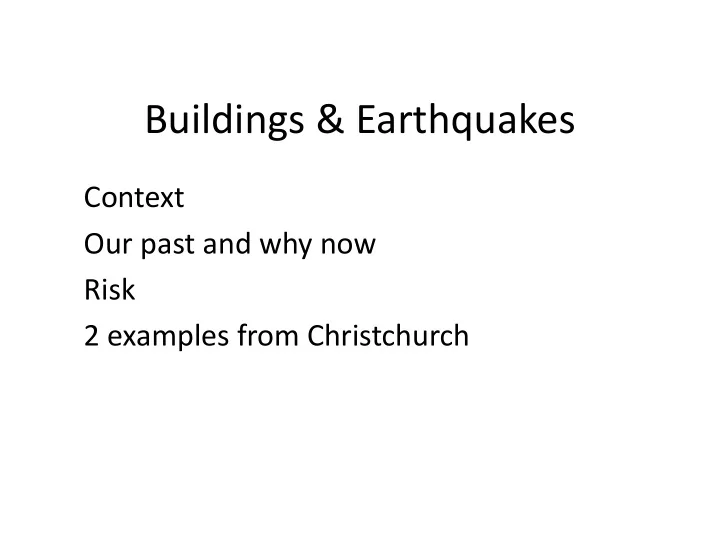

Buildings & Earthquakes Context Our past and why now Risk 2 examples from Christchurch
July 1843 7.6 Whanganui October 1848 7.4 Marlborough January 1855 8.2 Wairarapa October 1888 7.1 North Canterbury November 1911 7.1 Cheviot May 1919 7.0 Arthurs Pass June 1929 7.8 Murchison February 1931 7.8 Hawkes Bay March 1934 7.6 Pahiatua June 1942 7.2 Masterton June 1968 7.1 Inangahua September 2010 7.2 Darfield
• 1935 after the Napier earthquake – first entry of seismic requirements into the building code. • 1950’s tectonic plate movement becomes orthodox geology – the cause of earthquakes is understood. • 1960’s onwards NZ engineers visit all major earthquake sites immediately after they happen to measure and record building performance. • 1976 – first major change to the loading codes. Design values increase. Loading codes changes occur periodically until 2008. • Post 1976 to 2006 – materials codes are revised to incorporate new techniques to improve the behaviour of buildings in earthquakes. • Christchurch was the first test of the new methods. It has reinvigorated seismic engineering thinking.
Understanding the Risks Activity Indicative risks/Fatality risk per year Smokers:20 cigarettes a day 1 in250 Drinkers: 1 bottle of wine a day 1 in300 Drivers: motor cycling sports 1 in 700 Car drivers: 20 to 40 year olds 1 in 5,000 Pedestrians, Household workers 1 in 10,000 10,000km/year car travellers 1 in 10,000 Hikers in the mountains 1 in 20,000 similar risk to 34%NBS Air travel: plane crashes per flight 1 in 100,000 Living in buildings: death by fire 1 in 100,000 Death by lightening strike 1 in 1,000,000 Death by earthquake historically in NZ 1 in 1,000,000 Winning Lotto (odds of winning not death) 1 in 4,000,000
Compliance versus Performance %NBS Risk Grade >100 <1x A+ LOW RISK 80 - 100 1 - 2x A 67 - 80 2 - 5x B 34 - 66 5 - 10x C ERB 20 - 33 1 - 25x D EPB <20 >25x E
• This building was built in 1984. • Yellow stickered during the emergency period. • Limited access for engineering assessment. • The interior was a mess. Upstairs the glass partitions between offices were shattered and on the floor. • All the neighbouring buildings were empty. • Some had already been demolished. • There was a heritage building next door which was being made secure. • The early assessment of the visible damage suggested the building could be repaired. • An IEP rated the building at 33%NBS.
• The general area became classified TC3 – the ground is highly susceptible to liquefaction and settlement. • Measurements showed the floor slab to have settled differentially up to 100mm. • The insurer required to know what the cost would be to repair to both 34%NBS and 67%NBS. • This necessitated a detailed seismic assessment (DSA) • The DSA reduced the %NBS to 30%. • Using the plans and modelling the structure some additional critical weaknesses had been found. • Given the known ground conditions no strengthening was feasible without attending to the foundations.
• A geotechnical report was commissioned. • Site testing around the building was done using a cone penetrometer. • It confirmed a high water table at 1.2m and liquefiable soils to a depth of 13m. • It predicted earthquake settlements of 70mm to 141mm.
• The geotechnical report recommended piling as the only viable solution for stabilising the building against future earthquakes. • A preliminary design using 50 14m long micro piles was done and cost estimated. • The estimate of cost for repair to 34%NBS was $630,000 and $750,000 to 67%NBS. • However, even if the building was strengthened it would always be out of square and out of level. • The building was demolished.
• The building was given a yellow sticker. • In reality there are three structures in two buildings. • The larger building was of unknown age and there were no drawings of it available. • It consists of a two storied reinforced concrete frame with a flat roof in front of a single storey concrete frame with a pitched roof. Both frames are extensively in-filled with brick panels. • The other building was built in concrete masonry in 1984. There was a set of structural drawings available. • Attempts were made to ascertain what the concrete reinforcement was by destructive and non destructive means.
• IEP’s rated the two buildings at 6%NBS and 75%NBS respectively. • The older building was earthquake prone. • In view of the relatively light damage suffered by the structure , particularly in view of its proximity to the February 2011 epicentre, a DSA was done. • A DSA of the old building re-rated it as 40%NBS. • The tenant moved back in. • Structurally this building posed a number of issues, the lack of data and the brick infill panels so the reliability of the DSA result is not as good as it would have been had there been structural drawings available.
Recommend
More recommend